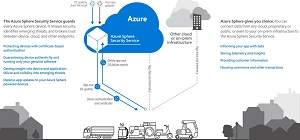News
New Azure Sphere Secures IoT Devices
Microsoft yesterday announced a preview of Azure Sphere for securely connecting Internet of Things (IoT) devices.
Announced at the RSA 2018 security conference, Azure Sphere is a three-part solution designed to ensure the safety of hooking up billions of devices to the Internet, focusing on the tiny microcontroller (MCU) chips embedded as the "brains" of such devices. They're responsible for hosting compute, storage, memory and an OS. While some 9 billion MCU-powered devices hit the market every year, relatively few are as yet connected to the Internet, the company said, but it expects that to change and is offering Azure Sphere to be ready for secure implementations.
The three-part solution includes:
- Microsoft's own cross-over class of Sphere-certified MCUs with security and connectivity built in by the company
- A special-purpose, Linux-based Azure Sphere OS with multiple levels of security baked in
- A turnkey Azure Sphere cloud-based security service guarding every device
The first chip, called the MediaTek MT3620, will ship this year, with partners participating in a private preview expected to come on board with their own offerings later. Development kits to work with the new offerings are expected mid-year.
 [Click on image for larger view.] Microsoft Azure Sphere (source: Microsoft).
[Click on image for larger view.] Microsoft Azure Sphere (source: Microsoft).
That development can be done in Visual Studio, Microsoft said, with a new Visual Studio Tools for Azure Sphere offering that will include application templates, development tools and the Azure Sphere software development kit (SDK). The company said it will help developers:
- Simplify and accelerate development
- Streamline debugging
- Modernize the development experience
To more quickly connect Azure Sphere devices to Microsoft's Azure IoT service, the company said a simple Visual Studio wizard will guide developers through the process, connecting devices to the Azure IoT Hub while adding needed code directly into an application.
Along with connecting devices to the Azure cloud, the wizard will enable the sending of telemetry from devices to the cloud, along with messaging going both ways.
About the Author
David Ramel is an editor and writer at Converge 360.